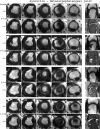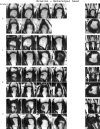The EULAR-OMERACT rheumatoid arthritis MRI reference image atlas: the metacarpophalangeal joints
- PMID: 15647417
- PMCID: PMC1766829
- DOI: 10.1136/ard.2004.031815
The EULAR-OMERACT rheumatoid arthritis MRI reference image atlas: the metacarpophalangeal joints
Abstract
This paper presents the metacarpophalangeal (MCP) joint magnetic resonance images of the EULAR-OMERACT rheumatoid arthritis MRI reference image atlas. The illustrations include synovitis in the MCP joints (OMERACT RA magnetic resonance imaging scoring system (RAMRIS), grades 0-3), bone oedema in the metacarpal head and the phalangeal base (grades 0-3), and bone erosion in the metacarpal head and the phalangeal base (grades 0-3, and examples of higher grades). The presented reference images can be used to guide scoring of MCP joints according to the OMERACT RA MRI scoring system.
Figures











References
Publication types
MeSH terms
LinkOut - more resources
Full Text Sources
Medical
Miscellaneous

